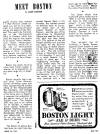
Home Page Meet Boston Menu Index
|
MEET BOSTON Friday, June 13, 1941 in What's New In Town W. J. Sidis |
Has anyone ever noticed that Hanover Street extends way out on to a dock, clear to a jumping-off place on the waters of the Harbor? This used to be the landing of the Winnisimmet Ferry to Chelsea, which was once the regular way across to all points north―Malden, Lynn, Salem, Newburyport, etc. The Ferry, which ran to the foot of Winnimmeset Street in Chelsea, suspended service in 1913. In Malden and Everett, the road to the ferry became important, and is still known as Ferry Street.
*
Boston has nearly twice as many local transit routes, in relation to its population, as any other large city in America.
*
Boston actually has a patron saint. Since Governor Shirley Winthrop came over here, representing the London office of the Massachusetts Bay Company, and changed the name of this town to that of his home town in England, it acquired the protection of the patron saint of the old English town. The English town was said to be named for its founder, a medieval monk named Biddulph or Botolph (Spelling was always rather fluid in those days.) Botolphston (Botolph’s town), was abbreviated to Boston. So our city has its patron saint―St. Botolph.
*
The Boston & Maine Railroad once ran right into Haymarket Square. Back in the Nineties, the railroad moved its terminal back to Causeway Street (part of the present location of North Station), and the rest of the right-of-way to Haymarket Square was used for the subway that was then being built. The location of the old freight switches now provides the space for the terminal trolley loop at North Station for the City Point and Egleston cars. The old railroad station in Haymarket Square is still standing. It was used as a relief hospital till a couple of years ago. The neighboring buildings on Canal Street were the old freight sheds and railroad offices. On Canal Street, opposite the freight sheds, was a row of hay and grain establishments; the municipal hay scales, set up in 1852, were removed only a few ago to make room for a new traffic circle. Hence the name Haymarket Square.
*
The Salem where the witchcraft panic broke out in 1692 is not the same place we know by that name at present. It was “Salem Village,” which is now called Danvers, where so many people were accused of being witches. Danvers is now known as the location of a large insane asylum.
*
The set-back row of buildings in Dewey Square, opposite South Station, is just in line with the Dorchester Avenue Bridge. Federal Street formerly extended right through to what was then the Federal Street Bridge, connecting with Dorchester Avenue in South Boston. When South Station was built, that part of Federal Street was cut off, and Atlantic Avenue was extended on one side of the station, and Dorchester Avenue along the other side (though it has to make quite a bend to reach the bridge).